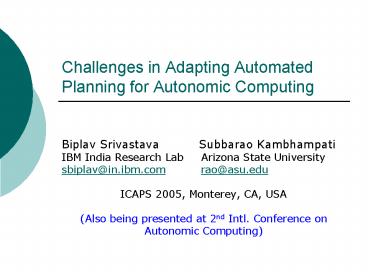Challenges in Adapting Automated Planning for Autonomic Computing - PowerPoint PPT Presentation
Title:
Challenges in Adapting Automated Planning for Autonomic Computing
Description:
Challenges in Adapting Automated Planning for Autonomic Computing ... A is a set of actions, Ai with. Aipre (preconditions) Aipost (postconditions) drawn from P ... – PowerPoint PPT presentation
Number of Views:58
Avg rating:3.0/5.0
Title: Challenges in Adapting Automated Planning for Autonomic Computing
1
Challenges in Adapting Automated Planning for
Autonomic Computing
- Biplav Srivastava Subbarao Kambhampati
- IBM India Research Lab Arizona State
University - sbiplav_at_in.ibm.com rao_at_asu.edu
- ICAPS 2005, Monterey, CA, USA
- (Also being presented at 2nd Intl. Conference on
- Autonomic Computing)
2
The Case for Automated Planning in Autonomic
Computing
- Biplav Srivastava Subbarao Kambhampati
- IBM India Research Lab Arizona State
University - sbiplav_at_in.ibm.com rao_at_asu.edu
- ICAC 2005, Seattle, USA
- Presented by Hemal Khatri
3
Planning in Autonomic Computing (AC)
- The P of the M-A-P-E loop in an Autonomic
Manager - Planning provides the policy engine for goal-type
policies - Given expected system behavior (goals), determine
actions to satisfy them - Synthesis, Analysis Maintenance of plans of
action is a vital aspect of Autonomic Computing - Example 1 Taking high-level behavioral
specifications from humans, and control the
system behavior in such a way as to satisfy the
specifications - Change requests (e.g., INSTALL, UPDATE, REMOVE)
from administrator in managing software on a
machine (Solution Install scenarios) - Example 2 Managing/propagating changes caused by
installations and component changes in a
networked environment - Remediation in the presence of failure
Autonomic Manager
Plan
Analyze
Knowledge
Monitor
Execute
Managed Element
4
Information Expected to be Available while
Planning in AC Scenarios
- Planning is ltP, I, G, Agt
- P is a set of predicates
- I and G are initial and goal states drawn from P
- A is a set of actions, Ai with
- Aipre (preconditions) Aipost (postconditions)
drawn from P
Scenario I (initial state) G (goal state) A (actions) S (existing plans) Constraints (domain constraints)
Self-configuring Yes Yes - - Yes
Self-healing Yes Yes Yes - Yes
Self-optimizing - - - Yes Yes
Self-protecting - Yes - Yes Yes
5
Comparing Current Status of Automated Planning
and the Needs of AC planning
- Highly scalable planners exist for synthesizing
plans of actions. However - They expect complete domain theories
- They focus on plan generation rather than plan
management
- Planning technology is relevant for AC computing,
but we also need - Ability to handle incomplete domain theories
- Focus on plan management rather than just plan
synthesis - Support mixed initiative continual (re)planning
Early systems in AC a) CHAMPS Domain-dependent
planner for self-configuration b)
ABLE-Planner4J Domain-independent
planning for self- but expects complete
I,G, A.
6
Planning with Incomplete Domain Theories
- Domain theory is partial if correctness cannot be
causally explained - Domain theory ? Explanation
? Modification - HTNs provide natural support
- Explainability Event vs. State constraints
- EVENT If you do a, then do b before c (dont ask
why!) - STATE The condition p is required by a and is
given by b - State constraints can be compiled to event
constraints. But the reverse?
- In Autonomic computing (as well as web-service
composition, scientific workflow handling), the
planner doesnt have access to complete and
correct specification - Action specifications may be incomplete
- Domain theory may be in terms of dependencies
- The planner cant always verify correctness
- ..but can certainly look for errors in a plan
7
Prescriptions
- AC Practioners
- Leverage current planning solutions in convenient
scenarios very efficient and will answer qns
such as - What interactions will occur if a new operation
is introduced into the plan - What high-level goals will go unsupported if an
action is removed - Expend time in effect-based modeling
- Complete specifications make it easy to provide
the causal dependency structure of the plan. This
in turn helps in plan-management by allowing us
to answer questions such as - What interactions will occur if a new operation
is introduced into the plan - What high-level goals will go unsupported if an
action is removed
- Planning Researchers
- In AC, we can at most expect incomplete
specification - Ordering constraints may be provided without an
explanation of why they are needed - Some information about incompatibility of actions
may be provided - Managing such plans poses two technical
challenges - Deriving additional dependencies between workflow
operations - Adapting planning techniques to deal with partial
causal information
8
Summary
- We developed an understanding of the planning
needs of AC computing - Connections with 2 other very close
applicationsWeb Services, and Scientific
Workflow management - Evaluated the match between existing planning
technology and AC computing needs, and identified
specific needed extensions - Currently focusing on plan synthesis and
management with incomplete domain theories (such
as are present in AC computing scenarios) - Impact will be measured in terms of availability
of information sought about the domain and
improvement in the quality of plans handled
(analyzed/ generated/ managed). - Benchmarking will be in the software installation
and problem determination scenarios.

